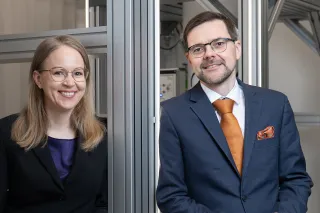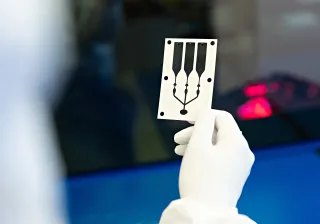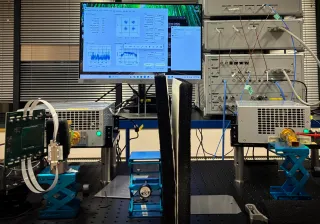Quantum technology revolution is expected to bring many unprecedented tools to our disposal, like for example, secure data transmission and efficient instruments for the design of complex drug molecules. The realization of such visions requires significant advances in the development of quantum devices, especially in microelectronics.
Microelectronics refers to small components or systems operating at the chip level. A typical practical example is the microprocessor of an ordinary laptop or mobile phone with up to tens of billions of transistors integrated onto a silicon chip of a square inch in size. Microelectronics is also increasingly used for miniature systems other than digital computing components. One example can be found right next to the processor of a mobile phone, namely the phone's camera, which uses microelectronics for imaging. Microelectronics will also be used extensively in quantum technology.
Microelectronics provides the foundation for the development of quantum computers
The first digital computers developed in the 1930s and 1940s were room-sized tools based on electromechanical switches or electron tubes. They could perform only simple tasks and consumed a huge amount of energy. A new approach for building high-performance computers was needed, and it was found in microelectronics. Mechanical switches and electron tubes were first replaced by transistors, after which an integrated circuit consisting of several transistors was invented. The first microprocessors were released at the turn of the 60s and 70s. Silicon-based microprocessors and transistors have since been further developed, for example by shrinking the size of transistors, which makes them faster and improves their functionality per unit area on a silicon chip. Thanks to this development, the processors of modern personal computers and mobile phones have billions of transistors, and their computing capacity is enormous compared to the first computers.
The leap in the computing capacity can be similar or even significantly more with quantum computers, especially, for certain computational tasks. However, building a quantum processor is much more complicated than a traditional processor, or at least completely different. In quantum computers quantum bits or qubits have to be formed into a relatively large system that functions quantum mechanically, i.e. coherently, during the computation. Qubits can be highly sensitive to external interactions and disturbances that cause the loss of quantum properties or the “quantumness”, i.e., produce so-called decoherence and thus computational errors. Thermal noise is a typical source of decoherence, which is one of the reasons why quantum processors are often operated at cryogenic temperatures, i.e., at extremely low temperatures close to absolute zero (-273 °C).
Although the microcircuits of traditional computers are not suitable for quantum computing as such, microelectronics provides powerful tools for building quantum processors and computers and improving their performance. Microelectronics is being harnessed to produce increasingly complex and reliable quantum systems on chip. Small-scale quantum processors with tens or hundreds of qubits have been demonstrated. In the coming years, further research and development work will have to be carried out in order to build larger quantum computers that can be used, for example, to simulate and design drug molecules.
Superconducting electronics and photons for computing and cooling
When a piece of metal is in a superconductive state, an electrical current can pass through it without any resistance. This peculiar phenomenon is observed in certain metals at low temperatures below the material-specific so-called critical temperature. Many superconducting microelectronic devices were originally developed specifically for sensing and metrology applications that require extreme accuracy. These technologies and devices are still used, for example, in brain imaging, mineral exploration and cosmology. Superconducting circuits also enable highly efficient and fast classical data processing. On the other hand, entire electrical circuits can behave quantum mechanically, which is why superconducting circuits are widely used in quantum computing. Presently, quantum computing can be considered as the engine of superconducting cryo-microelectronics as numerous quantum processor demonstrations use superconducting qubits and electronics.
Cryogenic quantum processors need to be accessed in some way to initialize and control quantum computing and to measure the results. At present, electrical wires are used for this, but it will not be a solution in large-scale quantum processors, for example, because a large number of metallic wires generate detrimental heat leakage into the cryogenic quantum processor. The solution is to use light waves or particles of light, i.e. photons, in the same way as in optical fiber based telecommunications. However, new microelectronic components, such as high-performance electro-optical transformers, need to be developed for such optical cryo-interfaces. Similar components are needed for long-range quantum communication and encryption.
When discussing photonics and electronics at chip level, it would be better to use a broader concept than microelectronics, and the appropriate definition would be microsystem. In this text, I focus mainly on electrical components, but it is important to note that photonics microsystems are one possible route to scalable quantum computing, which in this case would mainly utilize photons instead of electrical currents and electrons.
Advanced refrigeration methods are needed in quantum technology to achieve the necessary cryogenic operating temperatures. Typically, a large-scale cooling infrastructure, where the cooling liquid is formed from different isotopes of helium, is used for this. Simpler and more practical methods are actively being sought. One possibility is to use electrical current for cooling. For example, electrical current passing from normal metal to a superconductor can be used a coolant to refrigerate a chip containing quantum circuits. So, in the future, the cooling of quantum circuits could also be based on microelectronics. Cooling could also be possible with photons, because for example high-efficiency LEDs can emit a significant amount of heat along with photons.
Enabling materials
Minimizing the external unwanted interactions experienced by the quanta and qubits is important in the components of quantum technologies and computing, because these interactions lead to the loss of the quantum properties, i.e. decoherence. In the fight against decoherence, the resistance-free – lossless – flow of electrical current in the electrodes of superconducting quantum processors helps, but it alone is not enough. In addition, the platforms of the quantum circuits should have extremely low dielectric loss. That is, the platforms - or the so-called substrates - should capture as few photons as possible from the radio frequency electric fields used in the qubit operations. In principle, the materials should not have any defects that could capture photons of the fields. The more complex the device, the higher are the material requirements.
Currently, microelectronic materials, which minimize the losses and thus enable on-chip quantum properties to be preserved for as long as possible, are being developed. Aluminum-based superconducting qubits have been improving for about 20 years and the work is still on-going. Quantum processors of significant size can be built with the help of advanced materials - such as metal nitrides - and by managing the electromagnetic fields with good quantum circuit design practices. Niobium has been an important material in the development of integrated superconducting devices for many decades, for example because of its relatively “high” critical temperature ten degrees above absolute zero (-263 °C). Despite its relatively low critical temperature (-272 °C), aluminum is still used in the most elemental parts of actual superconducting qubits around the so-called tunnel junctions, because there aluminum simply provides superior qubit performance. Superconducting tunnel junction microcircuits made of niobium also play a key role in quantum technology, as they are used in extremely sensitive amplifiers that help to read, for example, the qubit states of superconducting quantum processors. In the future, due to the pursue of the performance improvements we expect that niobium and other materials will also be increasingly used in the most elemental parts of superconducting qubits.
What about silicon?
Let's go back to one of the main materials of microelectronics, silicon, which is actually a very important material for quantum processors and quantum technology in general. It provides a low-loss support - a substrate - for various quantum microsystems, but tiny silicon transistors themselves can also be used as qubits. In this case, they are operated in such a way that the number of electrons in the channel of a transistor is controlled with the accuracy of one electron. This operation regime of single electrons can be reached at cryogenic temperatures.
Unfortunately, cooling a traditional microprocessor in a mobile phone does not produce a quantum processor. The processor chip just turns into a passive grain of sand. In addition to low temperature, a rather different transistor architecture than that of a conventional processor is required. Silicon is one of the "new" materials for quantum computing and quite an attractive one as the several decades of silicon microelectronics know-how comes in use. Customized silicon transistors operating in the single electron regime have already been utilized to construct small-scale qubit systems on chip, but reaching large-scale silicon-based quantum processors still require significant research and development efforts.
Looking into the future
Optimizing materials and developing new components for the needs of quantum technology also lays the foundation for other novel technologies of the future. Microsystems developed for the extreme demands of the quantum world can be used, for example, in various sensors and, why not, also in classical computation. The growing industrial interest towards quantum technology has particularly changed the attitudes towards cryogenics. In the past, cooling to very low temperatures was considered impractical, and ideas requiring cryogenics were easily rejected by large IT companies. Low temperature physicists aptly called this phenomenon cryophobia. The phobia is now fading, and cryogenic devices are no longer considered a significant barrier to applications, which can change the playing field. It may be that, in the future, quantum technology is only the tip of the iceberg of cryogenics and cryoelectronics applications.
Perhaps, in the future, we will have cryo-enabled computers on our tables or laps, and these communicate with cloud-based quantum supercomputing resources. This would require the rise of the field of quantum microsystems and the quantum microelectronics within it. We are on our way and hopefully more growth will follow. Let's also remember that no one has a crystal ball. The future of technology is still as difficult to predict as next year's exact weather. For example, the switch called the transistor was not invented for computers and mobile phones, but it made them possible. This development was hardly predicted in the 1940s, when the first transistors were made. So, let’s wait and see what kind of game-changing and mind-blowing applications quantum microsystems will enable – in addition to quantum computing, of course.





